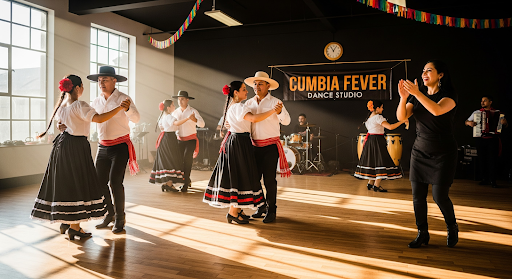Traditional dance forms may seem like relics of another era, yet they continue to shape how people move, perform, and express themselves today. Even with the constant stream of new trends, viral choreography, and fusion genres emerging online, dancers often return to cultural roots for grounding and inspiration. These time-honored styles offer rhythm, storytelling, identity, and community elements that still resonate deeply. This is one reason many dancers explore cultural techniques through options like cumbia dance classes, allowing them to learn both movement and meaning while gaining a richer understanding of cultural expression.
How Traditional Roots Shape Today’s Movement Culture
Traditional dance styles have been passed down for generations, often carrying stories, rituals, and shared cultural memories. Even in a world dominated by fast-paced choreography and studio experimentation, modern movers look toward traditional forms for guidance. These styles offer a foundation that builds essential skills such as rhythm awareness, musicality, balance, and expressive control. More importantly, traditional movement teaches dancers to listen to their bodies rather than imitate trends, which leads to a more genuine style.
Traditional roots also help dancers understand the cultural significance behind specific movements. When a dancer explores folk, Afro-Latin, classical, or indigenous forms, they often gain insight into the values and history of the communities that shaped the dance. This knowledge influences how they approach contemporary pieces, helping them perform with more intention and respect for the origins of the movement.
The Cultural Storytelling Power of Traditional Dance
Traditional dance styles often originated as a way for communities to celebrate milestones, honor rituals, or share collective histories. These dances are filled with symbolic movements that carry emotional and cultural meaning.
Why Storytelling Still Matters
Modern dancers are realizing that technical skill alone does not create memorable performances. Storytelling adds depth, allowing a dancer to embody emotion and intention. A powerful narrative transforms choreography from a series of steps into an experience that resonates with audiences. Traditional dances provide those narratives, giving dancers inspiration for shaping their own interpretations in modern contexts.
How Traditions Influence Contemporary Choreography
Traditional forms regularly influence the work of contemporary choreographers. Many incorporate folk footwork patterns, classical arm gestures, or cultural group formations into modern routines. These elements create fresh styles while still honoring their origins. Even small influences, such as rhythmic patterns or transitions, help dancers create innovative movement phrases that feel grounded in history rather than detached from it.
The Role of Rhythm and Musicality
Traditional dances are deeply connected to musical structures, rhythmic cycles, and percussive patterns. Because of this, they serve as valuable tools for improving timing and musicality in modern dancers.
Learning Rhythm Through Cultural Techniques
Dancers who immerse themselves in cultural movement often develop stronger rhythm awareness. Traditional music tends to layer beats, syncopation, and call-and-response structures, requiring dancers to listen closely and move with intention. These skills translate across genres, whether someone is dancing contemporary, hip-hop, or improvisational movement.
Why Consistent Practice Builds Skill
Traditional rhythms also encourage discipline. Repetition trains muscle memory and strengthens coordination. Over time, dancers become more confident and aware of their bodies. This leads to smoother transitions, cleaner lines, and a more expressive performance style. The lessons learned from traditional rhythms remain useful throughout a dancer’s entire career.
The Importance of Community in Traditional Dance
Traditional dance styles are rarely solo forms. They are practiced in groups, shared during community celebrations, and passed down through family and cultural gatherings. This community-based learning continues to inspire dancers today.
How Community Shapes the Learning Experience
Group dancing builds trust, cooperation, and awareness of shared space. Traditional formations require dancers to move in harmony, respond to others, and stay energetically connected. These skills are useful in studio settings, social dance environments, and stage performances. Dancers who begin in community-focused styles often carry that sense of unity into their modern work.
Why Modern Movers Seek Cultural Connections
Dancers today often crave emotional warmth and cultural grounding. Traditional dance offers both. Learning cultural styles allows movers to connect to heritage, understand shared traditions, and participate in a collective experience. This connection can be deeply motivating, whether someone is a beginner or a seasoned performer.
How Traditional Dance Inspires Innovation
Traditional dances continue to evolve through each generation, and this evolution fuels creativity in modern choreography.
Fusion Styles Emerging Today
Fusion genres blend cultural steps with contemporary influences. For example, a dancer may combine folk footwork with electronic beats or integrate traditional hand gestures into freestyle movement. These blends create unique styles that appeal to diverse dancers while still respecting the original forms.
The Value of Preserving Cultural Movement
While innovation is exciting, many dancers also recognize the importance of cultural preservation. Understanding the context behind traditional movements helps prevent misinterpretation and protects the integrity of the dance. This balance between honoring tradition and exploring new possibilities enriches the global dance landscape.
Why Traditional Dance Remains Relevant
Traditional styles remain influential because they offer more than choreography. They provide emotional grounding, cultural understanding, technical foundations, and a sense of belonging. These qualities help dancers grow not only as performers but also as storytellers and community members.
Exploring foundation-building styles through options like cumbia dance classes can give dancers a deeper appreciation for rhythm, culture, and movement history. As modern dance continues to evolve, traditional styles will remain a timeless source of inspiration, guiding dancers toward more expressive and meaningful movement.

